Class Mammalia
Order Order Eulipotyphla
Family Soricidae
Notiosorex crawfordi—Crawford's Gray Shrew // Notiosorex dalquesti—Dalquest's Shrew // Notiosorex harrisi—Harris' Shrew
Until recently, a single species (Notiosorex crawfordi [Crawford's Gray Shrew, also known as the Desert Shrew]) was recorded from post-Blancan faunas from our region. However, in 2003, a new species (Notiosorex cockrumi) was described from Cochise County, Arizona (Baker et al. 2003). More recently, all the Pleistocene and Holocene fossils of Notiosorex from the U.S. that were examined by Carraway (2010) were referred to two new species: N. dalquesti and N. harrisi. As a result, records of fossil Notiosorex crawfordi published before about 2010 that were not later examined by Carraway cannot be assigned to species without question.
Interestingly, from an evolutionary viewpoint, this leaves a very widespread extant species without a fossil record suddenly replacing two Pleistocene and Holocene species within a few thousand years at most. Possibilities are rapid anagenetic evolution, possibly from N. dalquesti; expansion of populations of N. crawfordi unrecorded in the fossil record at present; or a speciation event followed by rapid range expansion and replacement of the other species. McAliley et al. (2007) noted three clades of Notiosorex within the taxon traditionally known as N. crawfordi, with strong genetic differences between the clades but low variation within each clade. One of the possible explanations they gave for the low intra-clade variation was population bottlenecks. This would fit with greatly restricted population sizes in the Pleistocene (the bottleneck) followed by rapid geographic expansion.
Crawford's Gray Shrew currently is widespread in the lower elevations of our region (exceptionally up into Ponderosa Pine, but usually in the Upper or Lower Sonoran life zones).
The record of Notiosorex from the Animal Fair site (Harris 1993c) apparently is erroneous and is withdrawn.
Literature. Baker et al. 2003; McAliley et al. 2007.

Late Blancan: Tecopa Lake Beds (Whistler and Webb 2005).
Mid Wisconsin Térapa (Czaplewski et al. 2014)
Late Wisconsin: Dust Cave (Harris and Hearst 2012)
Literature. Czaplewski et al. 2014; Harris and Hearst 2012; Whistler and Webb 2005.
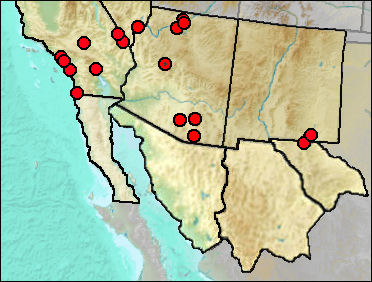
Carraway (2010) looked at a large number of Notiosorex fossils and named two new species on the basis of of her findings. She did not find any N. crawfordi in her large sample. The fossils from our region that she examined are listed under N. dalquesti and N. harrisi; specimens originally identified as N. crawfordi and not examined by her are listed here.
Sites.
Rancholabrean: Big Rock (Mead et al. 2005); Cool Water Coal Gasification Solid Waste Site (Jefferson 1991b); National City West (Jefferson 2014).
Sangamon: Naval Housing Unit (Jefferson 1991b); Newport Bay Mesa (Jefferson 1991b).
Wisconsin: Costeau Pit (Jefferson 1991b); Glen Abbey (Majors 1993).
Mid Wisconsin: Papago Springs Cave (Czaplewski and Mead et al. 1999).
Mid/Late Wisconsin: Bida Cave (Mead et al. 2005); Sandblast Cave (Emslie 1988); Vulture Cave (Mead et al. 2005).
Late Wisconsin: Antelope Cave (Reynolds, Reynolds, Bell, and Pitzer 1991); Hermit's Cave (Findley 1965); Lower Sloth Cave (Logan 1983); Mountain View Country Club (Jefferson 2014); Upper Sloth Cave (Logan and Black 1979); Wolcott Peak (Mead et al. 2005).
Late Wisconsin/Holocene: Deadman Cave (Mead et al. 1984); Kokoweef Cave (Reynolds, Reynolds, et al. 1991); Luz Foundation (Jefferson 1991b); Stanton's Cave (Olsen and Olsen 1984).
Literature.
Baker et al. 2003; Carraway 2010; Czaplewski and Mead et al. 1999; Emslie 1988; Findley 1965; Harris 1993c; Jefferson 1991b, 2014; Logan 1983; Logan and Black 1979; Majors 1993; Mead et al. 1984; Mead et al. 2005; Olsen and Olsen 1984; Reynolds, Reynolds, et al. 1991; Reynolds, Reynolds, Bell, and Pitzer 1991.
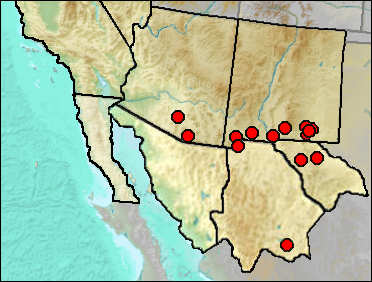
Carraway (2010) documents a known time span for this species from about 79 kya to a late Holocene level of Big Manhole Cave (545 ± 50 radiocarbon years BP: Lear and Harris 2007). The taxon was very widely distributed geographically, with occurrences from California to Kansas south to Chihuahua, Nuevo León, and Zacatecas.
This is the second smallest member of the genus, the smallest being N. harrisi, with which it was sympatric during at least parts of the Wisconsin and Holocene of New Mexico and Chihuahua. Carraway (2010) notes that the two species occur together in a number of 10-cm stratigraphic levels of late Holocene deposits in Big Manhole Cave.
Fig. 1. Lateral and lingual views of the dentary of Notiosorex dalquesti. The mandible is complete except for the largely missing angular process. The reduced red tooth pigment is typical of the genus Notiosorex compared to that of other regional genera. The specimen is from the 1-10 cm level, Howell's Ridge Cave. UTEP specimen 32-519.
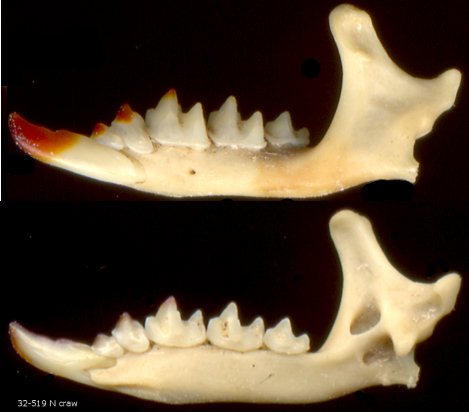
Sites.
Wisconsin: Big Manhole Cave (Carraway 2010).
Mid Wisconsin: Papago Springs Cave (Carraway 2010); Pendejo Cave (Carraway 2010); U-Bar Cave (Carraway 2010).
Mid/Late Wisconsin: Anthony Cave (Carraway 2010); Dark Canyon Cave (Carraway 2010).
Mid/Late Wisconsin/Holocene: Jimenez Cave (Carraway 2010); Sierra Diablo Cave (UTEP).
Late Wisconsin: Algerita Blossom Cave (Carraway 2010); Bison Chamber (Carraway 2010); Fowlkes Cave (Carraway 2010); Muskox Cave (Carraway 2010); U-Bar Cave 13-15 ka (Carraway 2010); U-Bar Cave 15-18 ka (Carraway 2010); U-Bar Cave 18-20 ka (Carraway 2010 [18-22 ka]); Wolcott Peak (Carraway 2010).
Late Wisconsin/Holocene: Balcony Room (Carraway 2010); Baldy Peak Cave (Carraway 2010); Howell's Ridge Cave (Carraway 2010); Pendejo Cave (Carraway 2010).
Literature.
Carraway 2010; Lear and Harris 2007.
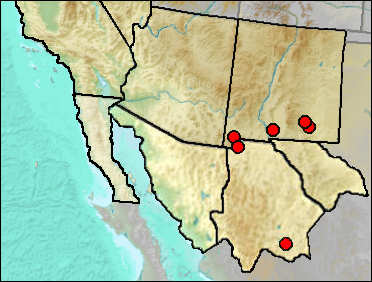
This is the smallest of the Notiosorex shrews. Carraway (2010) records it as appearing in the fossil record in the late Miocene of northeastern Arizona, from Wisconsin and Holocene deposits of New Mexico, and with a Pleistocene/Holocene record from southern Chihuahua.
Sites.
Mid Wisconsin/Holocene: Shelter Cave (Carraway 2010).
Mid Wisconsin: U-Bar Cave (Carraway 2010).
Mid/Late Wisconsin/Holocene: Jimenez Cave (Carraway 2010).
Late Wisconsin: Harris' Pocket (Carraway 2010); TT II (Carraway 2010 [as Dry Cave]); U-Bar Cave (Carraway 2010).
Late Wisconsin/Holocene: Beyond Bison Chamber (Carraway 2010 [as Beyond Balcony Room]); Burnet Cave (Carraway 2010); Howell's Ridge Cave (Carraway 2010).
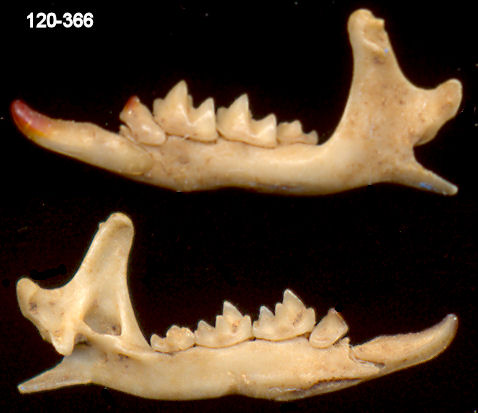
Literature.
Fig. 1. Lateral and medial views of the left dentary of N. harrisi (UTEP 120-366) from the BH Pit, 20-30 cm, Big Manhole Cave. Unicuspid 1 is missing.
Last Update: 7 Oct 2019